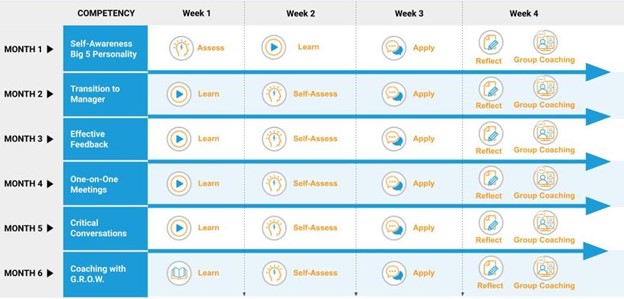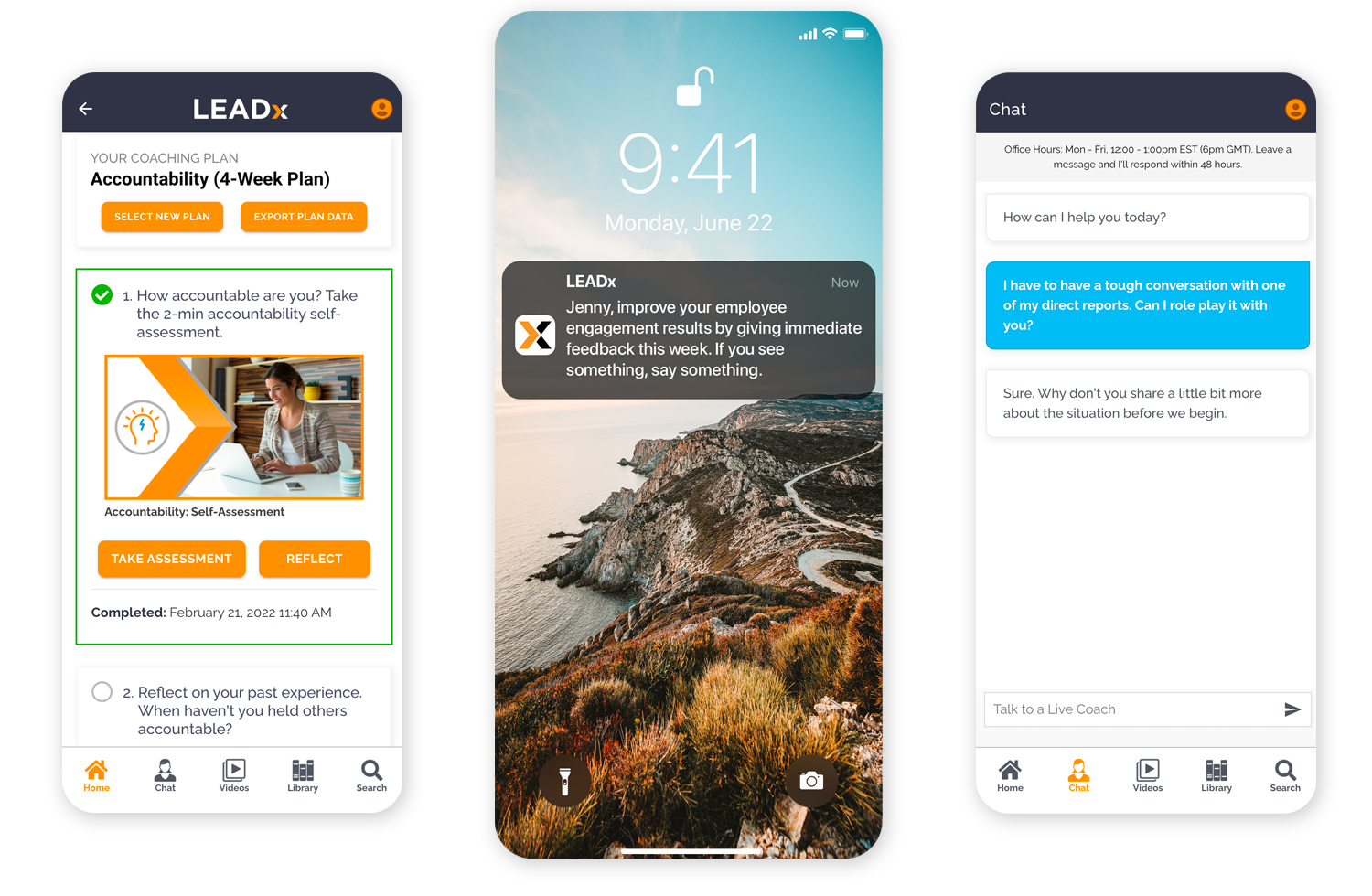
How To Make Your Leadership Coaching Program Highly Successful
One of the biggest critiques around leadership coaching is that it’s difficult to measure the impact, and difficult to prove that it works.
But, a recent study looked at all the existing research around the impact of leadership coaching and showed that this just isn’t true. The researchers looked at the entire body of research around leadership coaching’s impact on leaders. They found that coaching benefits leaders in five crucial ways:
- Performance and Skills
- Well-being
- Coping
- Work attitudes
- Goal-directed self-regulation
No wonder then that leadership coaching programs continue to grow. Some 54% of HR pros are planning to expand their coaching offerings in 2022.
So what exactly does it take to build or choose a highly successful leadership coaching program?
Knowing and Avoiding the Most Common Pitfalls
One of the best ways to build or choose a highly successful leadership coaching program is to look closely at the most common pitfalls and address them proactively. What follows are four pitfalls of a bad leadership coaching program and four ways to overcome those pitfalls.
Pitfall #1: Getting Lost in the “Wild West of Coaching.”
An article in the Harvard Business Review entitled “The Wild West of Executive Coaching” points out that executive coach selection is a “wild west” of options. Choosing a good coach is important but difficult.
How to overcome Pitfall #1: Selecting and Vetting Coaches
The Harvard Business Review article makes it sound maybe too extreme. Sure, there are a lot of coaches to select from, but it’s not entirely a “Wild West” scene. There are key qualities you can look out for. Here are five.
Key Degrees and Accreditations: Accreditations and degrees may only tell one part of the story, but it’s a fairly significant one. A good accreditation can help you ensure a certain degree of training, quality, and competence. For example, the International Coaching Federation (or ICF) is pretty widely considered the coaching accreditation gold standard. When it comes to degrees, graduate-level degrees in Industrial/Organizational (IO) Psychology and other related Psychology fields often entail coaching relevant training and learning.
Psychological Safety and Trust: Coaches should make leaders feel safe and comfortable. They shouldn’t feel like the company is spying on them through an external coach. They should feel like the coach genuinely has their best interest in mind.
A Diverse Bench of Coaches: Inevitably, not all coaches will be the right fit for every leader. Ideally, a coaching program will have a diverse bench of coaches that leaders can choose from.
Asking Questions, Not Giving Advice: The first-ever National Coach of Canada, Michael Bungay Stanier was awarded the honor for his brilliant work and writing around coaching. One of his core principles, which he writes about in The Coaching Habit, is this: Coaching for performance is about asking the right questions, not about giving advice.
Working with a Respected Organization: Lastly, if you’re looking to bring in outside coaches, it can help to work with a respected organization who has a track record of highly successful leadership coaching. What better way to check if coaching is high quality than to work with coaches who have left a trail of success. At LEADx we finish each coaching program by asking, “Was this the best coaching program you’ve ever attended?” That’s because we genuinely strive to build out the very best coaching programs and bench of coaches.
Additional Resources:
- If You’re Looking To Get Certified and Accredited Yourself
- Wiki Article on ICF
- Michael Bungay Stanier’s The Coaching Habit
Pitfall # 2: Measurement
A meta-analysis of leadership coaching (a study examining all the other existing studies) found that one of the greatest areas that’s lacking in leadership coaching is measurement. Specifically, they found that leadership coaching tends to over-rely on two forms of measurement: “Self-reported behavior change,” and “the client’s perceived effectiveness of coaching.”
Self-reported is more likely to be biased. Leaders may report improvement because they feel pressure to improve. On the other hand, as leaders get to know a topic more deeply, they may become more aware of what they’re doing incorrectly. As a result, they will rate themselves lower, even though this is a sign of progress.
The client’s perceived effectiveness is even more biased. It's borderline useless. Perceived effectiveness is vague and doesn’t get into specific behaviors, objectives, or desired impact. Worse yet, the client likely wants to see improvement because they invested in the coaching, so they will actively look for positive signs and signals.
How To Overcome Pitfall #2: Set Up A Measurement Plan With Your Coaching Plan
Plan out how you’re going to measure your success as a part of your actual coaching program. Examples of deeper forms of measurement that you might use include:
- Measuring impact on a specific behavior. For example, if you want leaders to improve their skills at giving you feedback, you might survey their direct reports before and after leadership coaching to measure improvement (ideally you will measure more than once to track longevity).
- Measuring impact on a specific outcome. For example, if your outcome is “employee engagement,” you would measure employee engagement before you coach leaders as well as after you coach leaders (ideally more than once to track longevity).
- Using a 360 assessment instead of a self-assessment. To avoid bias in self-reported ratings, you can use 360 assessments, which take into account ratings by direct reports, peers, and bosses. This can create a much more holistic evaluation of the ways coaching has impacted a leader’s behavior (or not).
There’s an added bonus to setting up a form of measurement before your build or select your leadership coaching program: You can build your program in accordance with the timing and approach to measurement.
Measurement is also a good moment to check in on pitfall #1. A skilled coach should take measurement into account and proactively plan around it.
Pitfall #3: Lack of Connection, Trust, or Safety in the Coaching Relationship
Comments from leaders who don’t trust or connect with their coaches might sound something like this:
- “I felt like my company was using my coach to spy on me, so I was intentionally optimistic, unrevealing, and safe in everything I said and disclosed.”
- “I didn’t feel like my coach understood me, and I never really felt comfortable sharing what I was working on and struggling with.”
- “I felt like my coach was judgmental and opinionated, and I was very cautious about what I shared.”
All of these comments boil down to a lack of trust, connection, and safety. With such a weak foundation for the coaching relationship, these coaches aren’t likely to get very far with your leaders.
How to Overcome Pitfall #3: Choosing Coaches Carefully and Diversely, and Giving Leaders More Options
There isn’t any one way to ensure that your coaches and leaders perfectly connect. That’s just not possible. But, there are a few things you can do to increase the odds. First, you can vet your coaches carefully (see pitfall #1). Second, you can build a leadership coaching program that contains options. Allow leaders to choose who they want to work with and change if it doesn’t feel like a good fit. This can help increase the odds that they find a coach who they build a rapport with. Third, you could consider trying group coaching, where one coach works with a small group of leaders. Other leaders can build a support network for each other and help to bring a diversity of perspectives and opinions.
Pitfall #4: The Learning Trap
One of the tougher pitfalls to catch is the coaching program that tends to put too much emphasis on learning. This type of coaching program can be highly engaging and coaches can be great at building rapport. They may even get great feedback. But, their over-emphasis on learning comes at the expense of actual behavioral change.
How to Overcome Pitfall #4: The 3-to-1 Method
Whether you’re building or choosing a coaching program, aim for behavioral change. Often this pitfall is closely tied to pitfall #2, measurement. If you don't measure some kind of outcome, it's tough to know whether or not behaviors are changing. At LEADx, we use the 3-to-1 model. The model says that for every one piece of formal learning, there should be at three on-the-job application exercises.

20 of the Most Common Leadership Coaching Topics
Another important consideration as you build or select a leadership coaching program is which topics you select. You might select hot topics, core competencies, or specific behaviors. Or, you might choose a blend of the three. There’s, of course, no single coaching topic that works best. You want to fit your topic with your audience. At LEADx, we’ve found that the following 20 topics are some of the most popular and impactful:
- Self-Awareness (usually with a personality assessment)
- Transition to Manager
- Effective Feedback
- One-on-One Meetings
- Critical Conversations
- Coaching With G.R.O.W.
- Strategic Vision
- Psychological Safety
- Building Trust
- Recognition and Appreciation
- Meeting Effectiveness
- Leading Change
- Resilience
- Decision Quality
- Innovation and Creativity
- SMART Goals
- Risk Taking
- Powerful Presence
- Accountability
- Drives Results
Additional Resources:
- 7 Ways To Leverage Management Coaching At Your Organization
- Coaching Skills For Managers: Why and How to Develop Them
Coaching Can And Should Be More Dynamic, More Action-Based
A lot has changed in the leadership development landscape as we move into the hybrid era. As the authors of “What Leadership Development Should Look Like in the Hybrid Era” wrote, training is “moving beyond the week in a classroom model of learning towards something more experiential and applied and partly virtual.” Leadership coaching programs that flex with the changing landscape will stay in front of the curve and achieve what all leadership development pros are setting out to achieve: behavioral change.






